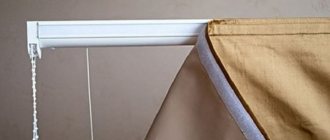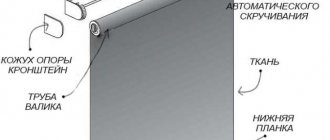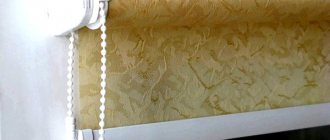A stylish, modern, practical element of the interior is a roller blind. Durable, functional, easy to use, they help create a special atmosphere of coziness and comfort in the room.
The positive properties of fabric roller shutters can only be preserved with proper care.
In this article we will tell you whether and how to wash roller blinds at home in a washing machine and by hand.
Is it possible to put it in the washing machine?
One of the features of fabric roller shutters is the special treatment of the fabric (made of linen, cotton or synthetic fabric). Impregnation with polymer compounds protects the fabric from rapid contamination (the fabric, without accumulating static electricity, repels dust and dirt particles), and also helps maintain the brightness of color and shape.
Frequent washing destroys the protective layer, so caring for roller blinds boils down to wiping the fabric with a damp cloth soaked in a soapy solution about twice a year.
Washing fabric roller shutters is recommended when the fabric has already lost its original appearance and ingrained stains have appeared on it.
Cleaning of roller blinds is carried out only by hand.
Washing in a washing machine will completely damage the product .
Wet cleaning of roller blinds made of bamboo and rice paper is strictly prohibited. For such products, only dry cleaning with a soft cloth is allowed.
General rules for washing curtains can be found here.
What detergents to use
When using soap or liquid, you need to prepare a 2-3% concentration of soap solution. A more saturated composition can negatively affect the color and impregnation of the fabric, and it will be more difficult to rinse.
If the manufacturer recommends certain cleaners, you should definitely use those products. Good results in terms of safety are shown by the so-called environmental detergent compositions. They act gently on fabric and dyes without causing damage to the structure or color changes.
Use washing powder especially carefully. It should not have a bleaching effect, nor should you use products that act as conditioners. The powder must be completely dissolved. Its pieces and particles can become attached to the canvas and, over time, form areas of discoloration, including under the influence of ultraviolet radiation.
If you are not sure that you can handle the washing yourself, the best way out would be to dry clean your roller blinds. True, this method is quite expensive, but it will save time and effort. In this case, it is worth giving preference to a company that clearly states that it works with similar products and has positive feedback from customers. Average companies, especially those equipped with outdated equipment, should not be trusted with your eyes closed.
Roller blinds are a practical, aesthetic and convenient way to decorate windows. With proper care and regular maintenance, they will retain not only their attractive and tidy appearance, but also their performance characteristics for many years.
How to properly clean at home?
In order for fabric roller shutters to retain their original appearance after washing, you must strictly adhere to certain rules.
Dismantling
Depending on the design of fabric roller shutters, there are several dismantling methods .
If the curtain is fixed on a spring bracket, first remove the plugs on both sides of the mechanism, remove the screws, and move the curtain rod to the side.
After such manipulations, the canvas is easily removed from the pipe.
If the roller shutter fastening is fixed with adhesive tape, then the cornice is removed along with the tape (carefully pry it off from the bottom with a knife blade). After dismantling, traces of the adhesive tape can be easily removed with alcohol.
Before you start washing, the dismantled roller blind fabric is carefully inspected for complex, old stains. Such contaminants must be removed before the main wash begins. Otherwise, the stains will eat into the fabric and only dry cleaning specialists can get rid of them.
Choosing a detergent
Roller blinds can be washed with laundry soap, liquid detergent or washing powder. In order for the laundry soap to dissolve in water faster, it is first rubbed on a coarse grater.
When using washing powder, it is important to ensure that the grains dissolve completely in the water. Otherwise, scratches and stains may remain on the surface of the canvas.
It is also necessary to carefully study the composition of the washing powder . For roller blinds, the use of powder with a bleaching effect is not recommended. You should also avoid hand washing powders (they are very difficult to rinse out).
The best option for washing fabric roller shutters is liquid gels. They have a gentle effect on the fabric, preserving its structure and color. It is prohibited to wash roller blinds with chlorine-containing products.
In addition to choosing the type of detergent, the concentration of the soap solution (no more than 2-3%) is important for washing fabric roller shutters. A concentrated, saturated soap solution can cause streaks, changes in color and thickness of the fabric impregnation.
Proper washing
Algorithm of actions:
Carefully lower the roller blind fabric into a bathtub with warm water and diluted detergent and rub it with a soft sponge on both sides with gentle movements, without pressure.- The already washed part of the roller shutter is carefully rolled up.
- The clean curtain is thoroughly rinsed with water (we use a shower). You can also use another rinsing method: take a full bath of clean warm water, in which you rinse (intensively raising and lowering) the roller blind.
It is necessary to rinse the roller shutters until water without soap begins to drain from the canvas. Otherwise, whitish streaks may appear on the curtains after drying.
Video instructions on how to clean and wash roller blinds so as not to spoil them:
How to wash roller blinds
To preserve the original appearance of the curtains, it is important not only to choose the right way to wash your roller blinds, but also to observe the following prohibitions:
- Bend roller blinds when cleaning. Also, the product does not tolerate excessive pressure.
- Use regular stain removers, detergents and washing powders. It is not recommended to use universal compounds that are suitable for all types of fabric.
- Iron blinds. High temperature treatment evaporates the special impregnation.
- Over-wet roller blinds. This will lead to leaching of the impregnation.
- Use scrubbers with hard bristles.
To prevent heavy contamination, it is recommended to clean roller blinds every 2-3 weeks in the summer. In winter, this procedure can be performed less frequently.
Users use 2 cleaning methods. For the first you will need a damp cloth or a vacuum cleaner. In this case, the canvas does not need to be removed from the fastening. The second option will require dismantling the roller blinds.
Preparing for washing
If you choose the second cleaning option (general cleaning), then before washing the roller blinds, the canvas must be removed. To do this you will need:
- Remove the roll from the clamp, being careful not to use excessive force.
- Remove the plugs located on the side parts of the structure.
- Pull out the gears, starting from the opposite edge of the chain.
- Move the cornice to the side and remove the canvas.
If the roller shutter is attached with adhesive tape, then the structure must be pryed off with a sharp knife, being careful not to damage the plastic. In this case, it is recommended to hold the cornice with one hand. Remaining glue can be removed with alcohol.
Washing method
There are two ways to clean roller blinds at home. The first is used to remove minor contaminants. In difficult cases, more thorough cleaning of the blinds will be required. To do this, use both specialized products (AOC, Fairy, Progress and others) with a neutral pH, as well as washing powder (without bleaching components), soap or dishwashing detergent. Next, you need to wash the roller blinds according to the following algorithm:
- Fill the bathtub with water so that it completely covers the linen and add detergent.
- Unfold part of the canvas and clean it with a sponge (brush with soft bristles). The procedure should be carried out delicately, without pressing on the material.
- Roll up the cleaned part and unfold the new one, repeating the steps described.
- Rinse the unfolded sheet in the shower. This stage can be completed only after foam stops escaping from the curtain (otherwise streaks will remain on the material).
After washing, roller blinds must be dried. It is prohibited to clean blinds using products that contain abrasive or aggressive substances, as well as chlorine. Do not use conditioner to remove stains.
How to dry properly
As with washing, roller blinds can be dried in two ways. For the first you will need:
- Hang the canvas over the bathtub on a wide base (it is forbidden to use rope or fishing line, as kinks will appear) and wait until all the water has drained.
- Lay out the fabric backing on a flat surface.
- Place the roller blind on top of the absorbent backing, carefully straightening out the folds.
- Wait until completely dry and roll the fabric into a roll.
In the second case, it is also necessary to hang the canvas in the bathroom, waiting until the water stops draining. Then the curtain needs to be rolled up, put in place and unrolled. After this, you should open a window or start forced ventilation. This way the moisture evaporates faster. At the same time, it is impossible to allow the formation of strong air currents, due to which the roller blind will twist.
How to wash without removing?
You can quickly clean roller blinds without removing the fabric. There are several ways to carry out such a reading.
We use a washing vacuum cleaner:
open the roller blind and remove dust from the canvas with a soft, dry cloth;- We install a special brush attachment on the pipe of the washing vacuum cleaner for cleaning fabrics or smooth surfaces;
- Using gentle movements, from top to bottom, we treat the roller shutter canvas with detergent, supplied through the brush of a washing vacuum cleaner;
- three minutes after treatment, carefully collect dirt particles.
We use wet wipes:
- roller blinds are deployed to the maximum;
- a microfiber cloth or a piece of soft natural fabric is moistened with water;
- Using gentle movements, without pressing, we wipe the fabric roller shutters;
- Leave the curtain open until completely dry.
Do not use a steam cleaner to clean roller blinds. A jet of hot air can damage the protective coating of the canvas.
The main thing: rules of care
Caring for roller blinds is easy. The main thing is to know and follow simple rules that will help preserve the appearance of the canvas longer.
- Regularly clean the curtains from dust using a dry cloth or vacuum cleaner.
- Try not to wet-clean curtains more than once every 4-6 months.
- Refuse strong chemical cleaners in favor of gentle products: a solution of laundry soap, dishwashing detergent or a special gel.
- Do not iron roller blinds. Impregnation of the fabric makes the material durable, but unstable to high temperatures. Using a hot device will only damage the fabric, and you still won’t be able to smooth out the creases - this fabric is less elastic than regular fabric.
- Do not dry curtains vertically and do not use clothespins or clothespins to avoid deforming the fabric.
Dry cleaning
Delicate dry cleaning will help preserve the original appearance of fabric roller shutters for as long as possible.
Dry cleaning can be done in several ways:
We use damp soft wipes .
It’s all very simple: roll the roller shutters to their full length and wipe them with a damp soft cloth using gentle movements, from top to bottom. This type of cleaning can be done once a week.- We use a vacuum cleaner . You can quickly clean the roller shutters from dust if you carefully walk over the unfolded sheet with a vacuum cleaner.
To avoid damaging the curtain, put a special attachment (a fabric bag) on the vacuum cleaner brush. The suction power of the vacuum cleaner is set to minimum. Dry cleaning with a vacuum cleaner is enough to carry out once or twice a month .
You should not clean roller blinds with rough cloth napkins. Otherwise, the integrity of the protective layer is compromised.
Cleaning methods
In addition to washing, there are other ways to clean roller shutters, namely:
- Dry cleaning.
- Wet processing.
- Dry cleaning.
See the manufacturers' recommendations on which method is suitable for your roller blinds.
Dry cleaning
Some types of rolls cannot be washed; they can only be dry cleaned. This can be done in two ways:
- vacuum. Pre-attach a fabric cover to the vacuum cleaner nozzle so that the exciting air flow does not damage the material;
- Wipe the fabric of the roll with a slightly damp, loose cloth or sponge without strong pressure. This cleaning is easy and effective, since the dust lies on the surface of the material due to its impregnation.
It is recommended to carry out dry cleaning once every two weeks, and using a vacuum cleaner once every two to three months is enough.
Wet processing
Wet cleaning of roller shutters is possible if there are no restrictions on washing in the instructions for use.
With this procedure, the rolls remain hanging on the window. Immediately you need to stock up on loose napkins:
- We soak one in a solution with a liquid gentle agent, and gently wipe the surface of the roll.
- Use a second clean, damp cloth to remove soap traces.
- Third, we absorb all the moisture.
Wet treatment is recommended once every six months.
On the Internet you can find harmful advice - to clean roller blinds with steam. This is absolutely not allowed! Hot, humid air changes the properties of the fabric and disrupts the polymer protective impregnation.
Dry cleaning
There are types of roller blinds that require dry cleaning only. Also, if you don’t want to wash or clean the rolls yourself or are simply afraid of ruining the curtains, then take them to the dry cleaner. Our specialists will thoroughly clean the curtains, remove stains and return the roller blinds to their original appearance.
This is a qualified cleaning method, but quite expensive.
Trust dry cleaning of roller shutters only to well-established organizations.
How to dry?
In order for the roller blind to retain its original appearance after washing, it must be dried properly.
Basic drying rules:
- Dry fabric roller shutters only in a horizontal position. It is forbidden to hang the canvas on a rope (creases will form), fix it by the plastic tip, squeeze or twist it.
- Dry roller blinds only in a straightened form, away from heat sources (radiators, gas heaters, air heaters). Ignoring this rule may cause deformation and discoloration of the canvas.
The correct method of drying: after washing, wait a while for the water to drain, then lay the curtain on a horizontal surface until it dries completely.
You can speed up the drying process if you periodically blot the fabric with soft cloth napkins.
It is strictly forbidden to dry roller blinds in a curled form. Ignoring this rule may result in an unpleasant musty odor.
Hand wash
When washing by hand, do not use products containing chlorine or aggressive components. A product with natural ingredients, laundry soap, is suitable.
First, you need to fill a basin or bathtub with water, depending on the size of the curtains, and dilute the detergent. Remove the blinds and soak them. Now you can proceed directly to washing.
Important! Strictly adhere to the temperature regime during washing. The water should not be hot. Be sure to check the manufacturer's recommendations.
Do not rub the roller blind fabric too hard with your hands or a brush. The movements should be circular. Then the roller blinds are rinsed until the water becomes completely clear. If a powder or detergent stain remains, it will be difficult to remove once it dries.
What to do with difficult stains?
The following tips will help you quickly remove stains:
Fresh stains can be easily removed with an ordinary school eraser. It is enough to wipe the stain gently, without pressing, and not a trace will remain of it.- Grease stains can be removed using laundry soap. It is enough to rub the stain with soap, leave the curtain for ten minutes, and then rinse the stain with clean water until the soap stains disappear.
- Salt or starch will help remove vegetable oil stains. It is enough to fill the stain and leave it for twenty minutes. Afterwards the fabric is wiped with a damp sponge.
- If there is chewing gum stuck to the roller blind, ice will help remove it. It is enough to put a few ice cubes on the gum or place the roller shutters in the freezer for a few minutes. The frozen chewing gum will easily separate from the canvas.
- Liquid dish detergent will help remove stains from dirty hands. Simply moisten the sponge with soapy water and wipe the stain. Remains of detergent are removed with a damp cloth.
- Special stain removers for roller blinds (do not contain aggressive chemicals or chlorine) will help remove stubborn stains.
Before you begin removing stains from roller shutters, the selected product must be tested on an inconspicuous, small area of the fabric.
It is strictly forbidden to remove stains with aggressive chemicals: gasoline, acetone, solvents, chlorine-containing compounds.
How to remove roller shutters from windows
The very first thing you have to do before washing is remove the roller blinds. The dismantling sequence is the same for approximately all types:
- remove the side plugs;
- remove the gears;
- move the cornice;
- remove the fabric from the roller shutter.
If you do not plan to wash it in an automatic machine, then it is not necessary to remove the fabric from the pipe. The entire procedure takes no more than 10 minutes. It is easy to remove the curtains, which are mounted using double-sided tape. It is carefully removed from the window or frame, then peeled off from the structure itself. It is even easier to dismantle curtains that are mounted with magnets.
Tips and prohibitions
You should not wash roller blinds often. Dry scrubbing or gentle wet cleaning will help keep your roller shutters clean, extending their service life.
What not to do with roller blinds:
wash in an automatic machine (machine washing will completely ruin the fabric);- dry hanging on a rope (to avoid deformation, the canvas is laid out only on a horizontal surface);
- iron with a hot iron (you can only iron through a special mesh at the minimum temperature);
- use powders with coarse abrasive particles for cleaning;
- use aggressive chemicals (gasoline, acetone, solvents) to remove stains.
Types of horizontal blinds
The method for cleaning blinds depends on what they are made of. There are three most popular materials for the production of horizontal blinds - aluminum, plastic and wood. Each of them has its own characteristics that must be taken into account in order to choose the best option for caring for these products.
Aluminum horizontal blinds
They are distinguished by higher flexibility than plastic blinds, but you should not subject them to excessive tests for strength and flexibility, as the slats can be irrevocably deformed. Aluminum blinds come in different colors, but they all have a pleasant glossy surface that shines in the sun. In order to maintain this pleasant appearance, you need to avoid harsh cleaning products containing solid particles. Choose creams, soap solutions, soft sponges. Do not use powders or hard sponges under any circumstances - they will damage the surface of the aluminum plates and create many micro-scratches on them, spoiling their appearance.
Stylish aluminum blinds
Due to the properties of the metal, aluminum blinds are less susceptible to complex contamination. Aluminum does not absorb dirt, and its smooth, glossy surface facilitates cleaning - this is a plus. But there is a minus - water stains are more visible on gloss.
Usually, all care for them comes down to wiping them from dust or soaking them in water for 10-15 minutes if the dirt requires soaking. To do this, the blinds will first need to be removed from the cornice. The specified time will be quite enough to cope with any contamination. To enhance the effect, especially if the lamellas are perforated or patterned, use a soft toothbrush that will reach dirt in hard-to-reach places without damaging the soft metal.
Plastic horizontal blinds
Plastic blinds come in different varieties – expensive and cheap. Accordingly, their quality will be different. For example, cheap plastic blinds are more fragile than aluminum ones
They can be broken if handled carelessly. As a rule, the slats of cheap blinds cannot be replaced, so you will have to change the entire structure
Expensive, high-quality plastic blinds are more durable than aluminum ones
They are more comparable to wooden blinds, but they have one important advantage over them - they do not crack from water. So we recommend that you choose this option if you are leaning towards plastic
Versatile and minimalistic plastic blinds
Plastic blinds, like aluminum ones, may sometimes need to be removed from the eaves and soaked in water. The fact is that plastic is more susceptible to contamination, and washing it can sometimes be problematic. When you are faced with a choice - soak it longer or rub it harder with a brush - it is better to choose the first option, which will be more gentle.
If you are removing blinds to clean them more thoroughly, proceed carefully and take care to keep the slats in order. Many people make the mistake not even while cleaning the plastic, but during drying. The blinds dry perfectly in their place - on the window. They do not need to be dried near a radiator or using other heating devices. Close contact with a heat source may damage the plastic!
Wooden horizontal blinds
The most capricious type of blinds. Being made from thin strips of natural wood, they contain all the disadvantages and requirements of wooden products. Firstly, they cannot be soaked, unlike the previous option - plastic blinds. When soaking wooden blinds, the same negative changes occur as with any wooden product. Wood is a delicate material and needs to be taken care of. Secondly, you need to use gentle products that will not cause irreparable damage to the structure of natural wood. It is best to choose products for washing natural wood products, as well as cosmetics for caring for them - this will help preserve their pristine beauty for a long time.
Wooden blinds are luxurious and very difficult to maintain
Damaging wooden blinds will be even more offensive than plastic ones, because their price is much higher
When buying window decor made from natural materials, you need to be prepared for the fact that you will have to take care of it and show more attention than in the case of practical materials. But the appearance will pay for these costs, right?
Stages of the technological process depending on the type of pollution
Dry cleaning of clothes is a chemical-physical process using effective solvents of different compositions. The most common cleaning agent used for cleaning clothes is perchlorethylene (PCE). It is also possible to use water and special surface-active liquids - detergents.
In addition to solvents, when cleaning clothes, other chemical materials are used for degreasing, stripping and stain removal. Liquids are selected depending on the technology (cleaning with water, solvents containing carbohydrates or perchlorethylene), the type of contaminants, and the material from which the items are made.
The stages of the technological process include:
- receiving clothes - this stage is very important. During the appointment, the specialist determines the type of material, defects of things, type of contamination, selects the necessary substances to remove stains, and processing technology. In addition, a contract is drawn up;
- sorting - at this stage, batches of items are assembled for subsequent loading into a special machine that performs chemical cleaning. Sorting is carried out according to the texture of the fabric, the color of the items, the level of contamination, since due to the individual characteristics, each fabric feels differently in the machine. Sorting by color is necessary so that dyes do not move from one thing to another;
- stain removal - this process is also called preliminary cleaning. The process is suitable for the most contaminated areas of clothing. To remove stains at this level, detergents and solvents are used. Surfaces are cleaned to remove stains using local light. Such tables are a surface with a hood located on them. Compressed air and steam are supplied using guns. A powerful air flow combined with water, solvents and fabric detergents effectively removes stains;
- Dry cleaning in a machine involves drawing out dirt using solvents from the fibers of the material and dissolving them. Dry cleaning equipment operates in a closed cycle. In the container, perchlorethylene, which has already absorbed dirt from things, is filtered and passes into the distiller, where it is cleaned. To protect workers and customers, dry cleaning equipment is equipped with an adsorber. The device absorbs solvent vapors formed during drying and, accordingly, removes them from things and the drum;
- finishing operations - basically, the finishing stage consists of ironing. This occurs on ironing surfaces using irons with steam supplied from the built-in steam generator. Mannequins and presses are also used.
Reception of clothes
Sorting
Removing stains
Machine washable
Ironing
Contamination occurs on the entire surface or locally. The most noticeable ones are stains or dust. The hardness of the material from salt, which is present in foods or sweat, is less visible. The color changes and an unpleasant odor appears due to acid or alkali contamination.
There are many substances that contaminate clothes, but some contaminants are similar to each other. They can be divided into the following groups:
- Soluble are those contaminants that dissolve during degreasing. These include fatty substances, oils, and waxes. Such contaminants do not dissolve in water;
- water-soluble - stains are divided into two types. The first type (sugar, salt) is easily dissolved in water, the second - partially (sauces, soups). These contaminants are called food contaminants;
- insoluble - these contaminants are completely insoluble in water or solvents. These include dust, soot, and pigment substances. The process of removing stains from fabric uses dry cleaning. The problem is that stains can appear after removal; resorption occurs, causing things to look gray;
- Contaminants in small areas of the product, which include varnish stains, blood, paint, are removed with preliminary cleaning, often manually using special tools.
In the conditions of dry cleaning enterprises, the factors that influence the ease and quality of removal are the type of contamination of the material, the number and type of stains, and the length of time they remain on things.
The cleaning method is selected depending on the type of contamination
What types of stains on blinds are there?
The choice of cleaning method for blinds depends on the specific problem you need to deal with, so we suggest you familiarize yourself with the most common problems and how to fix them.
Before choosing a method for cleaning horizontal blinds at home, make sure that it will be effective for the task assigned to it.
Dust: regular cleaning in detail
The simplest and most easily fixed problem is dust. In order to get rid of it, it will be enough to carry out dry cleaning. It is suitable when you need to quickly clean horizontal blinds at home without removing them from the window.
You can also use options with wet wipes, soap solution and an antistatic agent, which will prolong the effect and protect the slats from dust settling for some time.
Grease traces: how to clean horizontal blinds in the kitchen?
It’s good if in the kitchen, where heat pollution is usually found, you have practical and unpretentious blinds made of aluminum or plastic. Then to care for them you will need the following set of measures:
- Pour 0.5 liters of water into a small container.
- Add 250 ml of vinegar to the water (the proportion should always be 1 to 2).
- Wear rubber gloves for cleaning.
- Take a clean cloth and soak it in the solution.
- Wipe the slats.
That's the whole secret! Fast, easy and effective.
Blinds in the kitchen are a practical solution, but how to remove grease from them?
If you have wooden blinds hanging in your kitchen, don’t be discouraged - there is a way to help them too. You will need to buy a special liquid detergent for wood that will cope with grease marks. However, it is best not to allow wooden slats to become coated with grease.
Paints, markers
- Wipe the area with the marker stain with a cotton pad soaked in alcohol. This will help make the stain less durable and make it easier to remove in the future. The process may take several minutes. If alcohol does not help, try nail polish remover, but be careful - it can “eat” the color of the slats. Continue cleaning with soapy water;
- You can also use a cleaner for marker boards - they are sold in office supplies;
- Toothpaste can help, try rubbing it on the area with marker marks and then rinsing it off;
- Another way is hairspray. Spray it on the stained area, wait a minute, then wash off the varnish with soapy water;
- If you have all-purpose automotive lubricant (WD-40) on hand, try using it. Apply a small amount of lubricant to the stained lamella, then wipe it off with a clean cloth;
- A stain-removing sponge and a soft version of a hand pad may also come in handy.
Blinds in the kitchen are a practical solution, but how to remove grease from them?
Nicotine stains
Plastic absorbs nicotine very well, and therefore plastic slats, especially light-colored ones, quickly lose their cleanliness in a room where people smoke. The best way to combat yellowing is to use an aerosol to care for your car's plastic dashboard. It is also called interior cleaner.
This product was developed for salons where people smoke constantly. Due to the fact that this problem has long become quite acute and needed some means of help, special auto chemicals were developed containing strong formulas that easily eliminate traces of nicotine and tar.
Bring back the blinds to snow-white color!
You can also try regular soda - it will help if the situation is not too advanced and the plaque has not yet turned bright brown. Dilute baking soda with water to a paste and apply the mixture to stains on the slats. It will act like bleach. After a short time, remove the soda solution with clean water.











